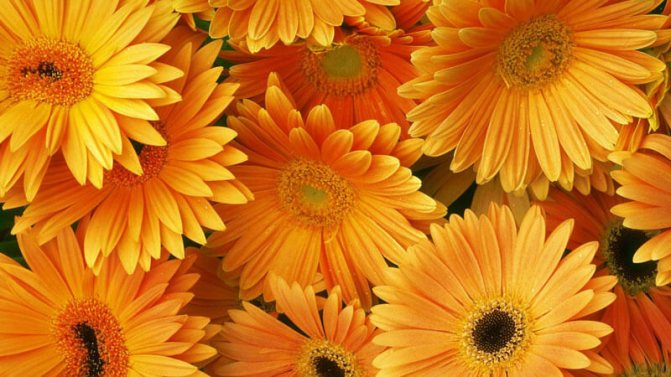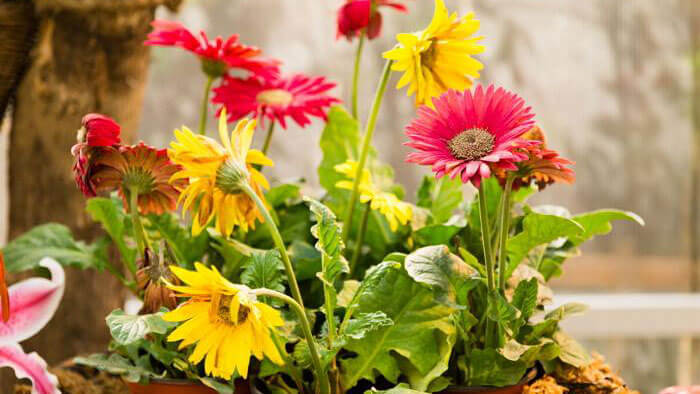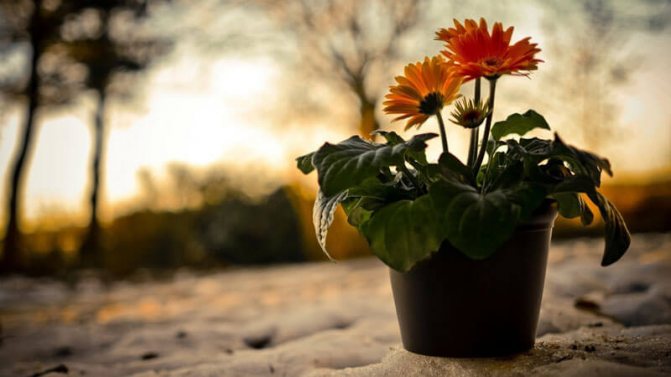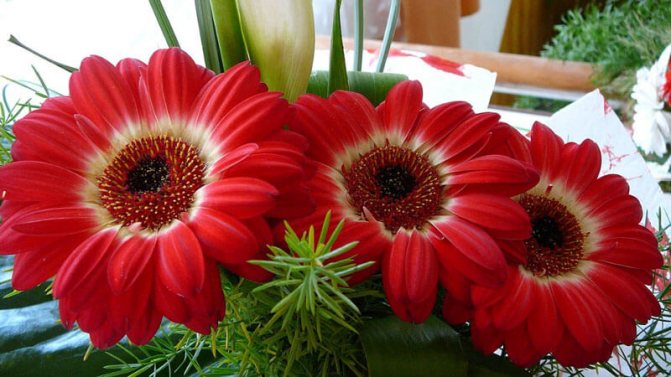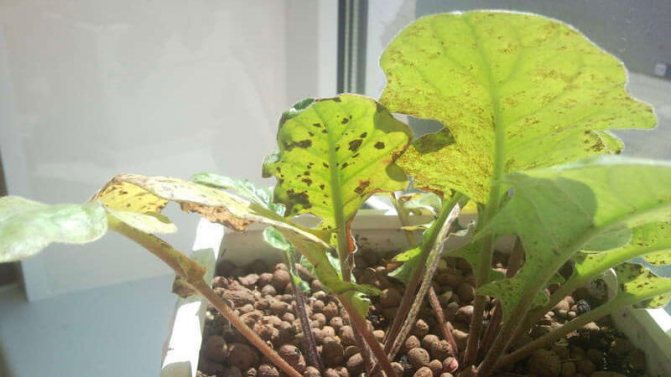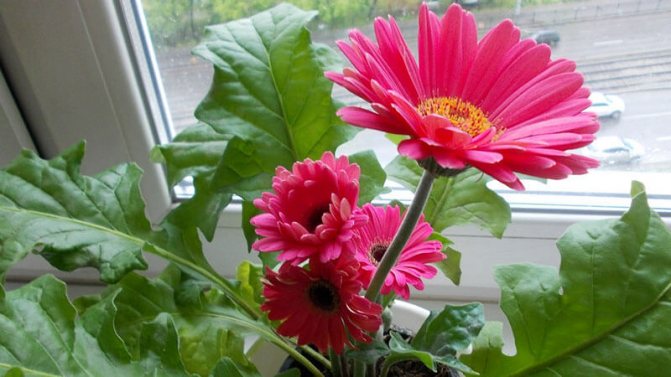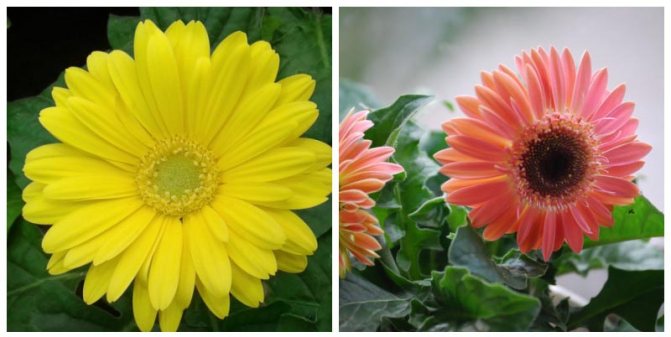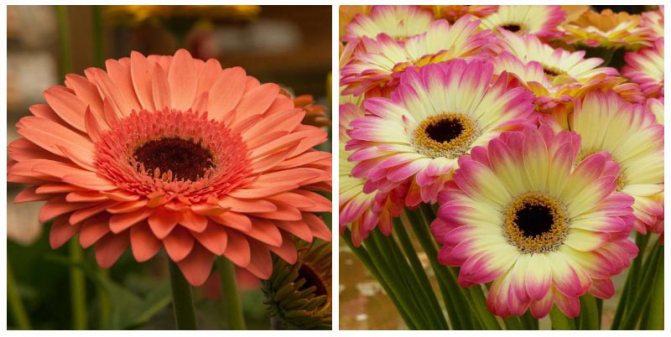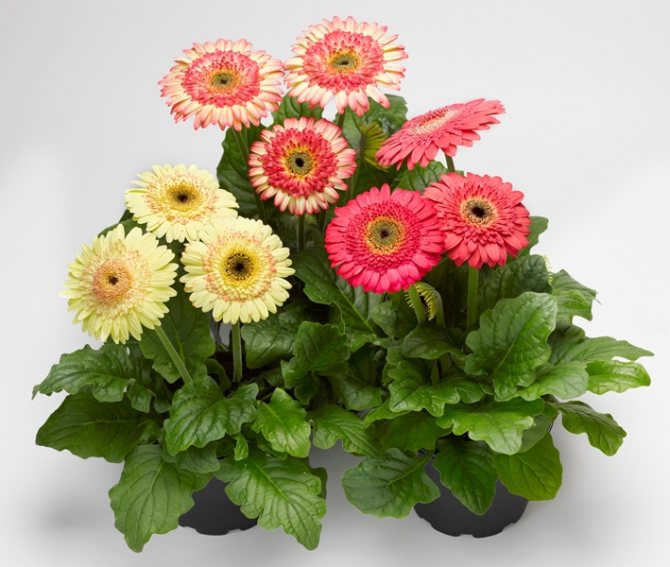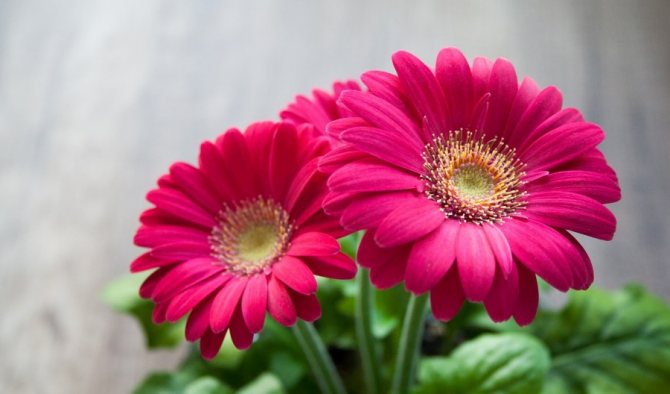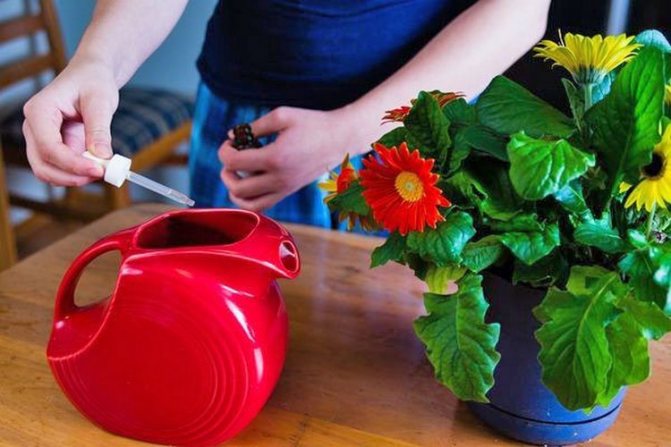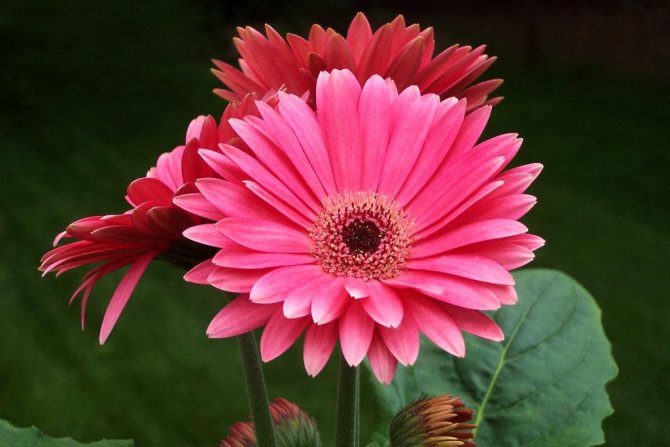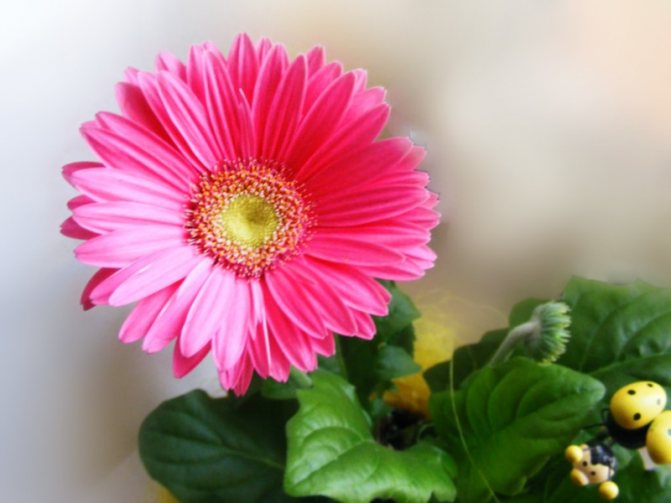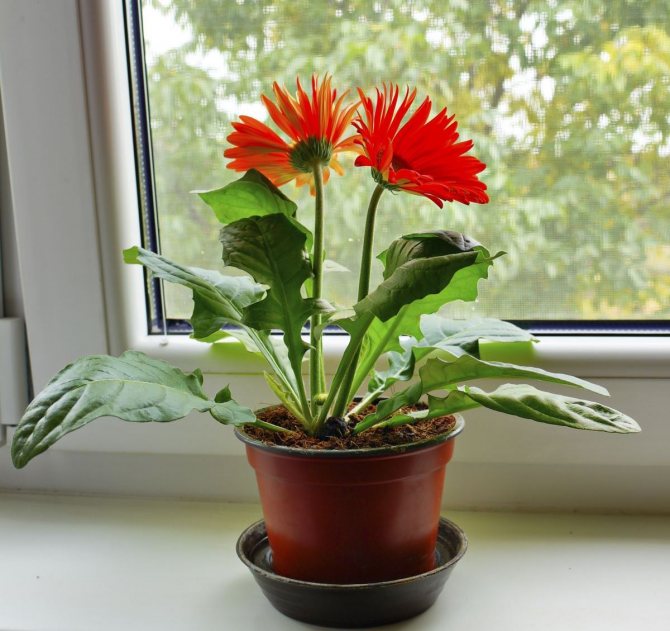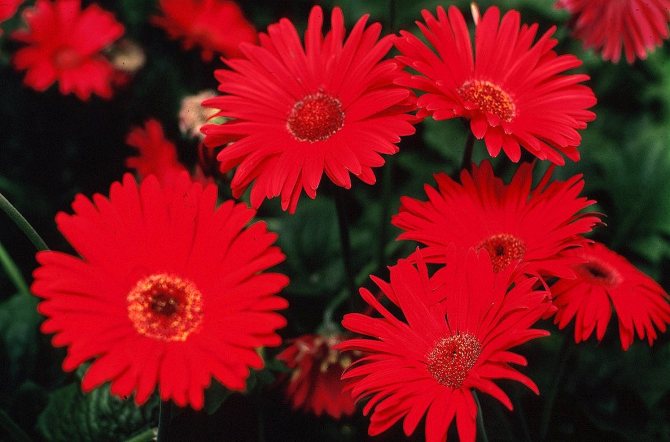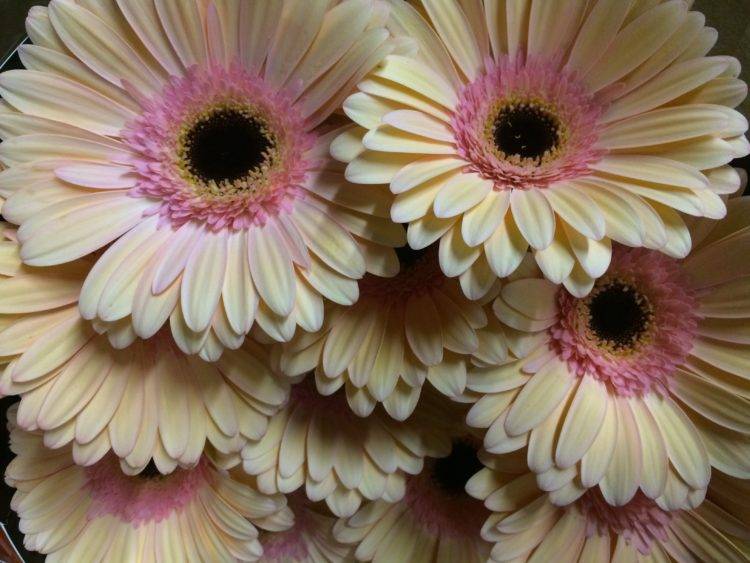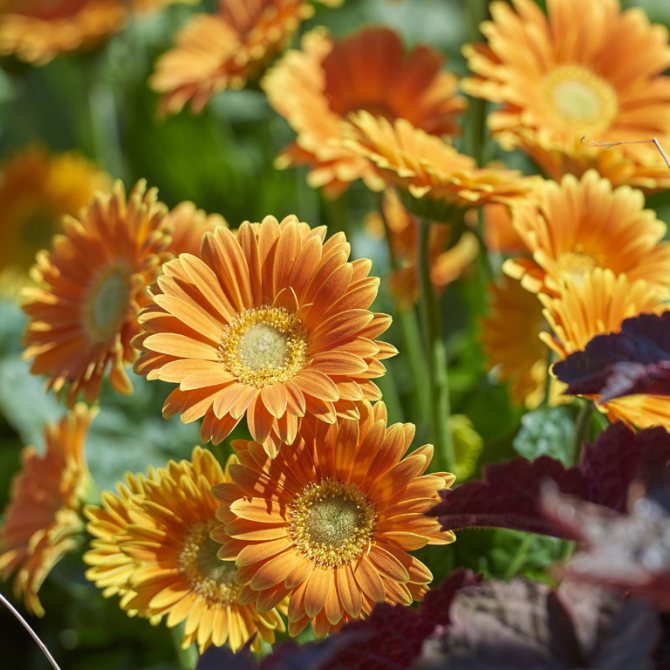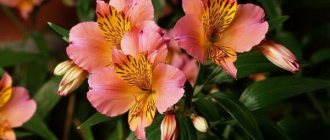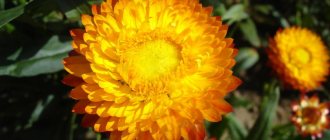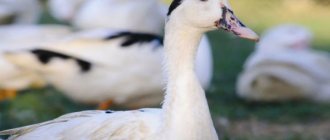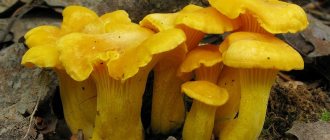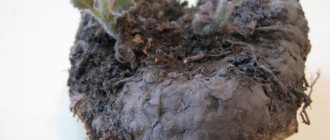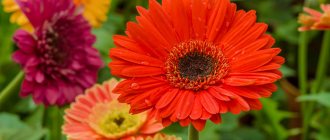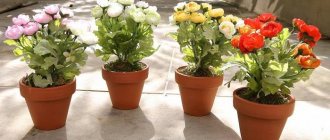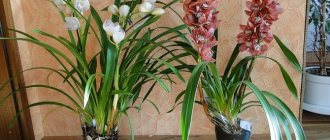Until recently, the gerbera was considered a garden or greenhouse plant, which fell into our homes in the form of lush bouquets of cut. But recently it has become fashionable to give bouquets of fresh flowers in pots - this way they bloom much longer, delight the eyes of others and create a festive atmosphere around. Gerbera is one of the most popular gift flowers. Her bright beauty is fraught with mystery, warmth and happiness. Certain varieties of gerbera have adapted well to the microclimate of our homes. For example, miniature gerberas that bloom in indoor conditions almost all year round. In this article, we will tell you about the types and varieties of this wonderful plant, as well as suggest which varieties are suitable for home growing.
Gerbera - description
The birthplace of the flower gerbera (lat.Gerbera) are the subtropical and tropical belts of Africa; the genus itself is part of the Compositae family and has approximately 70 species.
The gerbera flower is a herbaceous plant that has been growing for more than one year. The peduncle of this plant has no leaves and grows up to 60 cm in height. Gerbera leaves are collected in a rosette at the root, long - up to 35 cm. Baskets of flowers come in different shades, large flowers grow one at a time and reach 15 cm in diameter; some varieties have semi-double flowers.
Gerbera in indoor conditions is usually grown only one - gerbera jamesonii (Gerbera jamesonii).
Flower use
The main purpose of the plant is to decorate a landscape or a house. Bushes with large flowers themselves look like small compact bouquets. In landscape design, gerbera is used to decorate borders and mixed flower beds. Daisies, chrysanthemums, roses, calla lilies can become neighbors in the flower bed for her.
Bouquets from this delicate plant are very popular, because the flowers do not have an obtrusive smell and are suitable even for sensitive people. The plant is associated with honesty, tenderness and joy. Gerbera can stay in water for a very long time, the main thing is to properly care for the bouquet. To do this, cut the stems diagonally to increase the area in contact with the water. The liquid should be at room temperature. A couple of aspirin tablets are added to it. To prevent the stems from rotting, the water is changed daily.
Planting and caring for a gerbera
- Bloom: from late summer to early autumn.
- Lighting: bright diffused light. Additional artificial lighting may be required in autumn and winter.
- Temperature: during the growing season - about 20 ºC, in autumn and winter - 14-15, but not lower than 12 ºC. During flowering, the difference between day and night temperatures should be significant - at least 5 degrees.
- Watering: during the growing season - moderate, after the top layer of the substrate has dried. During the dormant period, the substrate is barely moistened so that it does not dry out completely.
- Air humidity: increased, but it is impossible to spray the plant, it is better to keep it on a pallet with wet pebbles.
- Top dressing: during the period of active growth, twice a month with a complex mineral fertilizer for flowering indoor plants. In winter, no top dressing is added.
- Rest period: from mid-autumn to late winter.
- Transfer: as needed in the spring. Do not bury the socket in the ground.
- Substrate: loose, moisture and air permeable, with a pH of 5.5-6.0.You can use a ready-made potting mix for asters, or mix leafy soil with sand and peat in equal proportions.
- Reproduction: seeds and division of the rhizome.
- Pests: aphids, whiteflies, scale insects, mealybugs.
- Diseases: the plant may suffer due to poor care or improper maintenance conditions.
Read more about growing gerberas below.
Reproduction methods
Gerbera can be propagated by seeds, dividing the bush and cuttings. Since the seeds quickly lose their germination, it is recommended to plant them soon after collection. For crops, boxes are prepared filled with loose fertile soil (perlite, sand, peat, leafy earth). Seeds are spread on the surface and sprinkled with wet river sand. After careful moistening, the pot is covered with foil to create a kind of greenhouse. Airing is carried out twice a day, and spraying as needed. The greenhouse should be kept at a temperature of + 16 ... + 20 ° C.
Seedlings begin to appear in 8-12 days. From this time on, the shelter is removed, and watering is carried out more often, but with great care. With the appearance of a pair of true leaves, gerbera seedlings dive into a new box with a distance of 7-8 cm. The presence of 5-6 leaves in the seedlings indicates the need for transplanting into separate small pots. Flowering will come in 9-11 months.
A large bush periodically gives root processes. In spring, they can be separated from the main plant and planted in separate pots or on a flower bed. To make the vegetation more lush, 2-3 sprouts are planted in one hole.

An adult gerbera can be divided into equal parts during transplantation. To do this, the rhizome is carefully freed from the ground, and then cut into slices with a sharp blade. Without letting the roots dry out, they are immediately planted in new soil and watered.
Gerbera care at home
Lighting
Gerbera at home needs a lot of light, and it can even grow with a small amount of direct sunlight, but on the southern windows it is still better to shade the plant in the summer. There may not be enough lighting for the plant on the north windows, so windows on the west and east sides are the best option. In the summer, the indoor gerbera can be taken out into the garden or in a private courtyard, but it is necessary to shelter the plant from the sun at noon, and the plant must be accustomed to this level of illumination gradually in order to prevent burns. In autumn and winter, it will not be superfluous to illuminate the plants with fluorescent lamps.
- Orchid roots rot, dry - what to do?
Temperature
Home gerbera loves warmth, therefore, in spring and summer, the temperature should be kept at a level not lower than 20 ° C, optimally - 24 ° C. After the gerbera has bloomed in room conditions, and during the winter, the optimal temperature is 14 ° C - the temperature should not drop below 12 ° C. When the gerbera is in bloom, the temperature difference between day and night should not be significant because this can reduce the ornamental value of the flower.
Watering gerbera
Water the gerbera with warm water, during the growing season - in moderation. Again, the difference between soil and water temperature should not be too great to keep the plant from getting sick. Watered with soft, previously settled water after the top layer of the soil has dried, watered carefully, not allowing water to enter the rosettes of the leaves, because this will lead to rotting of the plant. During the dormant period, the gerbera is watered so as to prevent the soil from drying out, and the plant can get sick from over-watering.
Spraying gerbera
Despite the fact that indoor gerbera loves high humidity, it cannot be sprayed. You can spray the air around the plant without letting water get on the leaves, or you can put a pot of gerbera plants on a tray moistened with peat or expanded clay.
Gerbera bloom
An interesting feature of the gerbera plant is that flowering depends on the length of daylight hours. The plant blooms from late summer to early autumn, when daylight hours are reduced.
Gerbera feeding
Gerbera is fed with complex mineral fertilizers during the active growing season. It will not be superfluous to fertilize with magnesium sulfate. If the temperature is low, additional phosphorus can be added. In winter, it is better not to feed the gerbera at home.
Gerbera transplant
The gerbera is transplanted in the spring, if needed. It is necessary to ensure the availability of high-quality drainage, and the substrate must be with an acidity level of pH 5-6. When replanting, the earth must not be allowed to enter the leaf outlet, and the outlet itself must not be dripped.
- Orchid roots rot, dry - what to do?
Gerbera propagation by division
When multiplying by division, the main advantage is the ability to preserve the characteristics of the mother plant. You can share gerbera flowers if she is at least 3 years old, optimally - 4 years old; divided in the spring. When dividing into each part, it is necessary to leave at least 2 points of growth, then the plant can bloom the next year.
Gerbera from seed
Gerbera seeds are sown in spring in nutritious, loose soil. The substrate is prepared from two parts of sod, one part of leaf and one part of humus soil with the addition of sand. When 2-3 true leaves appear on the home gerbera, the first pick should be done. The second pick is done in the 5-leaf phase, but immediately into separate pots. It is necessary to feed only a month after the plants have been planted in separate pots.
Location
Gerbera loves sunny sills of windows facing east or west, but in other places well lit by diffused sunlight, it will feel great. It should be shaded from the direct midday sun, and at other times the sun is simply necessary for it. Due to its compactness and chic appearance of its inflorescences, gerbera can become an adornment of any corner of your home. You can find a place for her in the bedroom, in the hall, in the living room and even in the kitchen. It is safe for allergy sufferers. Drafts - not afraid, but loves fresh air - so do not forget to ventilate her corner regularly. In the summer, the plant can be taken out on the veranda, balcony or even in the garden, where it will have an excellent warm season outdoors.
Diseases and pests of gerbera
Gerbera leaves turn pale. Excessive illumination may cause castings to become paler. To prevent this from happening, the gerbera needs to be shaded at noon from direct rays in spring and autumn.
Gerbera fell ill. If the humidity is too high and proper ventilation is not provided, then the plant can get sick with fungal diseases.
Gerbera leaves brighten. If, after purchase, the plant turns pale and loses its original appearance, then this either indicates that the plant is adapting to a new place, or it does not have enough light.
Gerbera leaves lose their brightness after purchase. The information will be useful: greenhouse plants are grown for sale and special substances are added that make the leaves bright.
Gerbera withers and dies. Gerber needs to be watered very carefully, because excessive soil moisture can destroy the plant, especially if the plant is kept in cool conditions during the dormant period.
- Orchid roots rot, dry - what to do?
Gerbera pests. Gerbera is not indifferent to aphids, whitefly, scale insects and ticks.
Briefly about the history of appearance
Gardeners have known what gerberas are for a long time. Charming bright daisies appeared thanks to the associate of K. Linnaeus, the Dutch botanist J.F. Gronovius. He discovered them in South Africa during his expedition in 1717.
Gerberas - what are these flowers, planting and care in the garden
For 20 years, the plant remained unnamed, and then it was named as "gerbera". There are two versions of the origin of this appellation:
- from the Latin word "herba" is translated as "grass";
- the flower was named after T. Gerber, who was a close friend of Gronovius.
For your information! Gronovius brought the plant to Europe, but other botanists did not appreciate it due to the difficulty in care. The plant did not take root, hurt, did not want to bloom. The recognition to the gerbera came only with the filing of the geologist and botanist R. Jameson, after whom the variety of this flower was named.
The main problems in growing
Why do the leaves turn yellow
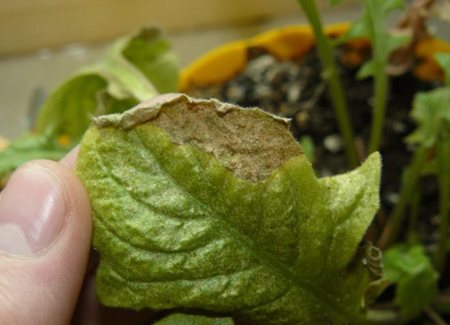

With Alternaria, brownish specks are visible on the foliage.
Then the leaves begin to fade, turn yellow.
Also, with a mosaic, spots of a yellowish-green color appear, and then leaf necrosis develops.
It is best to treat the gerbera with Radomil Gold.
In this video, once again on how to properly care for a room gerbera:
How to achieve lush bloom
Despite the love for the bright sun, the plant stops blooming if the light is too abundant. Gerbera needs no more than 12 hours of daylight. It blooms most luxuriantly from late August to November.


If a gerbera has not bloomed for more than 3 months, this means that the reason is not in the light, but in something else. A plant can stop forming buds if planted in a pot that is too large for it, then the culture directs all its forces to the growth of rhizomes. If you put nitrogen under the gerbera, it will also stop flowering.
What kind of pot is needed
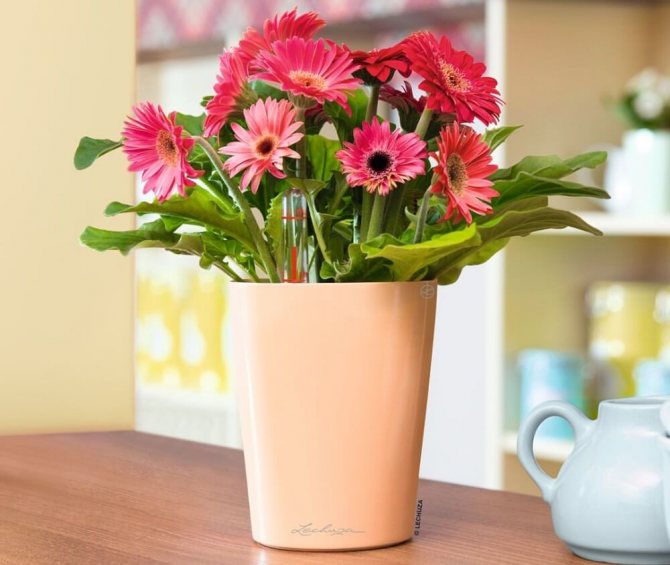

The diameter of the pot should not be too large, only 2-3 cm wider than the root system of the flower. The tightness in the pot is one of the conditions for the abundant flowering of gerbera. The volume is approximately 1–1.5 liters.
A deep unglazed ceramic pot is best suited for a gerbera - this will allow air to flow well to the roots of the plant. But, in winter, on a cold windowsill, gerbera roots in such a pot can be overcooled. This should not be allowed, because the gerbera is very sensitive to this. In this case, foam or a wooden support under the pot for thermal insulation will help.
Temperature
The optimum temperature during the growing season and flowering is considered to be 20-25 grams. in the daytime and 18-20 gr. at night. This is in line with natural indicators in her homeland. During the winter rest, the temperature in the room is reduced to 14–16 degrees, while reducing the irrigation rate. At 12 gr. heat gerberas go into hibernation: almost all processes slow down, flowering is excluded. Temperature 8-10 gr. It is critical for the domestic gerbera, although in its native places it also tolerates lower temperatures due to the fact that the roots there, nevertheless, are in warmer and wetter layers of the soil.
The flower does not like sudden changes in temperature, especially during flowering. Heat at 30 gr. and above, the gerbera also does not tolerate well - the inflorescences wither quickly, the leaves lose their tone. On such days, remove the flower in cooler places, shade it, ventilate the room more often.
Soil composition
Photos will help you to understand the intricacies of the transplant. Indoor gerbera, home care for which is described in the article, is not picky about the composition of the soil.
You can choose a simple universal soil for flowering plants. The condition is loose, slightly acidic soil, nutritious, but without rotted compost and manure, these additives can burn the roots.
You can prepare soil for gerbera yourself, here are the options:
- One part of pine bark, 4 parts of fertile soil, two parts of peat, two parts of sphagnum moss (dry).
- Three pieces of leafy land, one each: river sand, peat, charcoal.
Air humidity
Gerbera does not tolerate dry air. The optimum humidity level for her is 70–80%.If the indicators are greatly reduced, especially during the heating season, the humidity must be increased by all available means. It is not advisable to spray the plant itself - neither the leaves nor the flowers like this. But it is very necessary to regularly spray the space surrounding the flower, creating a water suspension or fog around the gerbera. There are other ways to increase the humidity in the room, for example:
- place the pot in a deep tray, on the bottom of which a layer of wet expanded clay, pebbles, sphagnum moss or coconut fiber is poured;
- cover the batteries with wet towels;
- create a “company” for gerbera from other plants that evaporate moisture from the leaves;
- place wide containers of cool water around the gerbera;
- buy and use a household humidifier.
If the humidity in the room, on the contrary, is too high, above 80-85%, this will create vulnerability of the gerbera to fungal and other infections, especially in winter. In this case, airing, reducing the number of waterings, and canceling spraying will help.


